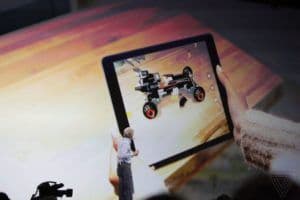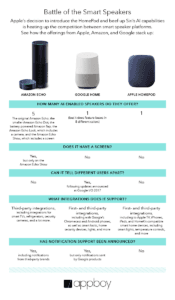Sound and Vision: Apple Goes Big on Speakers and Augmented Reality at WWDC
Published on June 05, 2017/Last edited on June 05, 2017/7 min read


Todd Grennan
Content Production Principal, Content Marketing at BrazeWhen it comes to Apple announcements, people expect mystery. Steve Jobs’ “One more thing” surprise announcements have become as iconic a part of his image as his ever-present black turtleneck—and current Apple CEO Tim Cook has kept up the tradition in recent years. When we think of Apple’s annual Worldwide Developers Conference (WWDC), we tend to think of these moments of stagecraft, when a pause and a knowing smile introduce a transformative new technology.
In the run-up to this year’s WWDC, held June 5–9 at San Jose’s McEnery Convention Center, rumors circulated that Apple would announce both a Siri-enabled smart speaker to compete with Google Home and the Amazon Echo, and that it would launch a new augmented reality (AR) platform, possibly in the same vein as Facebook’s recent AR launch. But, Apple being Apple, the biggest question remained: what will the surprises be?
As it turned out, the only mystery at this year’s WWDC was its lack of mystery. Apple announced that Siri-powered speaker—named the HomePod in a nod to the original iPod and the way it transformed music—as well as ARkit, an augmented reality development platform for iOS. But the rest of the event was dedicated to solid, useful (but not earth-shattering) updates and refinements to existing Apple platforms and products. Updates to the iPhone control center. Faster MacBooks. A new look for the App Store.
But even though there wasn’t surprise announcement that actually surprised anybody, both HomePod and ARkit are big moves that can tell us a lot about the current technology landscape. Let’s dive into both those announcements and what they could mean for the future of customer engagement.
The Rise of Post-Pokémon AR
When the Pokémon Go mobile app launched last year, augmented reality almost instantly gone from long-simmering emerging technology that was discussed mostly in tech circles to something that tens of millions of people around the world were using day-in and day-out. And while Pokémon hasn’t maintained its early dominance, it still served as a real-life demonstration of the potential that augmented reality has to provide users with entrancing, delightful experiences that seamlessly connect the real world with digitally-created objects and experiences.

An augmented reality Lego car created using Apple’s ARkit (Source: The Verge)
This has driven a number of major players in the tech space (including Facebook and Google) to make augmented reality a major priority—and investment—going forward. During WWDC’s opening keynote, Apple joined that group with the announcement of ARkit, which makes it easier for developers to add high-quality AR capabilities to their iOS apps. During the keynote address, attendees saw an ARkit test app that supported the seamless, real-time rendering of virtual objects within a real-world environment, with applications as simple as adding a digitally-created cup of coffee to a table and as complex as dramatizing an entire three-dimensional alien attack on stage.
ARkit makes creating those kinds of experiences on iOS devices easier and opens the door to widespread adoption of AR across the Apple product ecosystem. While not every brand is going to want to include augmented reality within their native app experience, there are a number of verticals that could see mobile customer interactions transformed by this technology.
What might that look like? Imagine a retail app that allows in-store customers to see digitally-created objects pointing out personalized clothing recommendations and highlighting flash sales in real time. Or a travel app that shows AR walking directions to a user’s airport gate that adjust as they move.
Cross-platform experiences and the AI assistant arms race
Over the last year, smart speakers have become an increasingly significant part of the tech landscape. Google launched its Google Home smart speaker last spring, while Amazon’s pioneering Echo line of AI-powered smart speakers saw their holiday sales increase 9x year over year and announced so many third-party integrations at this year’s CES consumer electronics show that the event became a kind of coming-out party for the device.

Enter the Apple HomePod. While WWDC primarily focused on HomePod’s high-end sound quality, the device is very much a smart speaker in the vein of Google Home and the Amazon Echo. The speaker is powered by Apple’s Siri personal digital assistant and features robust integrations both with Apple products like iPhones, iPads, Macs, and Apple TVs, and third-party smart home products through Apple’s HomeKit. And like Google and Amazon’s speakers, HomePod is expected to serve as a sort of operating system for tomorrow’s smart home, making it easier to automate your home using simple verbal commands.
“HomePod, Apple’s Siri-controlled speaker, ties the company to its musical heritage and offers an opportunity for a new product to make up for the lack of demand for the Apple Watch,” Russ Shaw, founder, Tech London Advocates and Global Tech Advocates said following the event. He noted that Apple’s AI-related updates—along with the company’s announcements around augmented reality—showed the company’s new focus on these technologies, “reflecting the growth that these two verticals in particular have enjoyed over the past 12 months.”

While the announcement of HomePod is good news for anyone reluctant to buy a Google Home because the sound quality wasn’t top-flight, Apple’s entry into the smart speaker market is probably more significant because it serves as more evidence that digital assistants like Siri, Google Assistant, and Amazon Alexa are poised to become the missing link between smartphones and smart home devices.
That reflects a growing reality when it comes to digital customer interactions: there is no one master platform. People are moving seamlessly between smartphone and computer, between two and three and four different messaging platforms, and using mobile devices at home and in-stores and on the go. That makes it more important for brands to have a presence on the platforms and devices that their customers use, and to make sure that they have the ability to gather customer data from all of those locations in real time, in order to support effective, platform-agnostic engagement strategies. Not every device will be equally important to every brand, but if your audience base uses a smart speaker like the HomePod, you should be thinking about how you can leverage that platform—otherwise, you may well be ceding it to your competitors.
While Siri is an integral part of the HomePod experience, it’s the cross-platform nature of Apple’s digital assistant that makes it powerful. During WWDC, Apple made a point to highlight significant improvements to Siri’s natural language and machine learning capabilities on multiple operating systems, making it possible for users to benefit from improved recommendations and functionality on every major Apple device. And coming on the heels of this year’s Google I/O, where Google argued for an AI-first view of the future, Apple’s efforts to beef up Siri into a worthy competitor for the Google Assistant demonstrate how seriously both tech giants are taking artificial intelligence and its potential to positively influence the user experience. That makes it even more important for brands to stay up to speed on developments regarding machine learning, deep learning, and other AI-related topics.
Final thoughts
For a company known for charting the future of technology with bold, innovative announcements, this year’s WWDC showed another side of Apple—Apple as a market-follower. And while only time will tell if HomePod manages to unseat the Amazon Echo as the preeminent smart speaker (or to live up to analyst predictions that it will sell 10 million units in its first year), the decision to enter that market and to join Google, Facebook, and others in focusing on augmented reality is a major sign that both of these spaces will be an increasingly big part of our lives. Brands that are serious about staying ahead of the curve should take note.
To make sure you’re on top of all of the biggest developments from WWDC, Google I/O, this spring’s other big tech events, and what they mean for the future of customer engagement, check out Appboy’s next Technology Briefing at 1:00 p.m. on Wednesday, June 21. During this free webinar, thought leaders will weigh in on the most important developments and provide best practices for responding effectively. Register now!

Be Absolutely Engaging.™
Sign up for regular updates from Braze.
Related Content
View the Blog
How behavioral marketing turns data into personalized experiences

Team Braze

Experience optimization: Turning data insights into better journeys

Team Braze

December 2025 Bonfire Marketer of the Month: Jagex’s Emma Oliver
